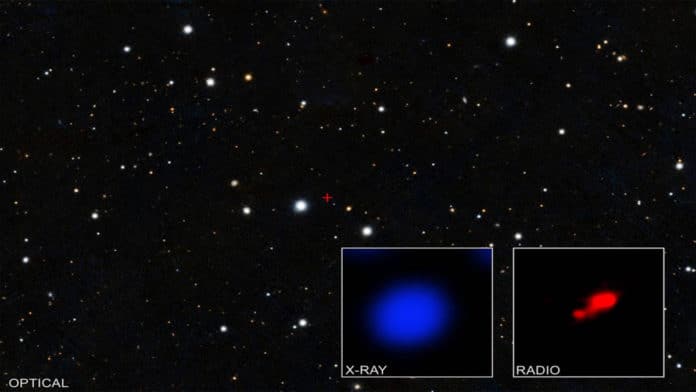Using NASA’s Chandra X-ray Observatory, astronomers have discovered the evidence for a farthest cloaked black hole at about 6% of the current age of the universe. This is the first indication of a black hole hidden by gas at such an early time in the history of the cosmos.
It is quite difficult to find quasars in this cloaked phase because so much of their radiation is absorbed and cannot be detected by current instruments. The Chandra has the ability of X-rays to pierce through the obscuring cloud.
The new discovery originated from observations of a quasar called PSO167-13, which was first discovered by Pan-STARRS, an optical-light telescope in Hawaii. Optical observations from these and other surveys have recognized around 200 quasars already shining brightly when the universe was not exactly a billion years old, or around 7 percent of its present age.
These reviews were just viewed as viable at discovering unobscured black holes, on the grounds that the radiation they recognize is stifled by even thin clouds of gas and dust. Since PSO167-13 was a part of those perceptions, this quasar was expected to be unobscured, too.
Astronomers tested this idea by using Chandra to observe PSO167-13 and nine other quasars discovered with optical surveys. After 16 hours of observation, only three X-ray light photons were detected from PSO167-13, all with relatively high energies. Since low-energy X-rays are more easily absorbed than higher energy ones, the likely explanation is that the quasar is highly obscured by gas, allowing only high-energy X-rays to be detected.
Co-author Niel Brandt of Penn State University in University Park, Pennsylvania said, “This was a complete surprise. It was like we were expecting a moth but saw a cocoon instead. None of the other nine quasars we observed were cloaked, which is what we anticipated.”
An interesting twist for PSO167-13 is that the galaxy hosting the quasar has a nearby companion galaxy, obvious in data recently acquired with the Atacama Large Millimeter Array (ALMA) of radio dishes in Chile and NASA‘s Hubble Space Telescope. Because of their nearby separation and the faintness of the X-ray source, the group was not able to decide if the newfound X-ray emission is related with the quasar PSO167-13 or with the companion galaxy.
On the off chance that the X-rays originate from the known quasar, at that point space experts need to develop a clarification for why the quasar showed up exceptionally obscured in X-rays however not in optical light. One probability is that there has been an enormous and quick increment in the cloaking of the quasar during the three years between when the optical and the X-ray observations were made.
On the other hand, if instead, the X-rays arise from the companion galaxy, then it represents the detection of a new quasar in close proximity to PSO167-13. This quasar pair would be the most distant yet detected.
In either of these two cases, the quasar detected by Chandra would be the most distant cloaked one yet seen, at 850 million years after the Big Bang. The previous record-holder was observed 1.3 billion years after the Big Bang.
The authors plan to follow up with more observations to learn more.
Co-author Franz Bauer, also from the Pontificia Universidad Católica de Chile and associate member of the Millenium Institute of Astrophysics said, “With a longer Chandra observation we’ll be able to get a better estimate of how obscured this black hole is and make a confident identification of the X-ray source with either the known quasar or the companion galaxy.”
Co-author Roberto Gilli of INAF in Bologna, Italy said, “We suspect that the majority of supermassive black holes in the early universe are cloaked: it’s then crucial to detect and study them to understand how they could grow to masses of a billion suns so quickly.”
A paper describing these results is accepted for publication in Astronomy and Astrophysics and is available online.
